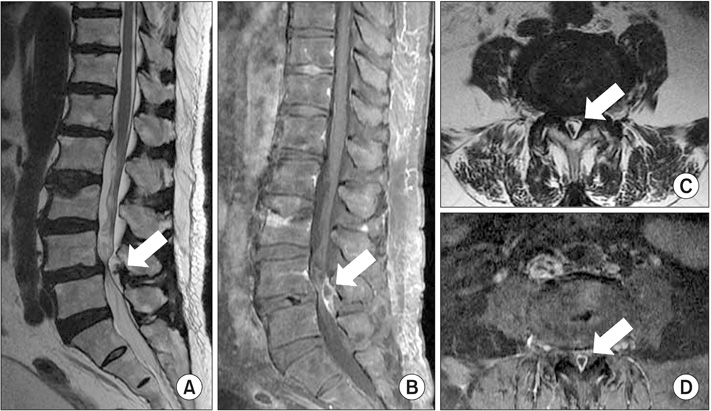J Korean Orthop Assoc.
2017 Dec;52(6):556-561. 10.4055/jkoa.2017.52.6.556.
Cauda Equina Syndrome by Facet Synovial Pseudocyst Secondary to Epidural Injection
- Affiliations
-
- 1Department of Orthopedic Surgery, Seoul Red Cross Hospital, Seoul, Korea.
- 2Department of Orthopedic Surgery, Konkuk University Medical Center, Konkuk University School of Medicine, Seoul, Korea. sthkim96@gmail.com
- KMID: 2421350
- DOI: http://doi.org/10.4055/jkoa.2017.52.6.556
Abstract
- A 77-year-old woman presented with bilateral leg weakness, accompanied by severe axial back and radicular pain, after a L4-5 epidural injection. She had been receiving misappropriated epidural injections for the last few months. A contrast-enhanced magnetic resonance image showed rim enhancing, spinal canal compromising cystic lesion at the posterior epidural space of L4-5. During surgery, a severely central compromised non-communicating cystic lesion located at posterior epidural space was resected. A histological report of this lesion confirmed a pseudocyst containing a degenerated synovial tissue. Herein, we report our experience of cauda equine syndrome after epidural injection with successful treatment.
Keyword
MeSH Terms
Figure
Reference
-
1. Baker JK, Hanson GW. Cyst of the ligamentum flavum. Spine (Phila Pa 1976). 1994; 19:1092–1094.
Article2. Doyle AJ, Merrilees M. Synovial cysts of the lumbar facet joints in a symptomatic population: prevalence on magnetic resonance imaging. Spine (Phila Pa 1976). 2004; 29:874–878.3. Asamoto S, Jimbo H, Fukui Y, et al. Cyst of the ligamentum flavum: case report. Neurol Med Chir (Tokyo). 2005; 45:653–656.4. Farfan HF, Sullivan JD. The relation of facet orientation to intervertebral disc failure. Can J Surg. 1967; 10:179–185.5. Kirkaldy-Willis WH, Wedge JH, Yong-Hing K, Reilly J. Pathology and pathogenesis of lumbar spondylosis and stenosis. Spine (Phila Pa 1976). 1978; 3:319–328.
Article6. Howington JU, Connolly ES, Voorhies RM. Intraspinal synovial cysts: 10-year experience at the Ochsner Clinic. J Neurosurg. 1999; 91:S193–S199.
Article7. Okada A, Harata S, Takeda Y, Nakamura T, Takagaki K, Endo M. Age-related changes in proteoglycans of human ligamentum flavum. Spine (Phila Pa 1976). 1993; 18:2261–2266.
Article8. Haase J. Extradural cyst of ligamentum flavum L 4: a case. Acta Orthop Scand. 1972; 43:32–38.9. Métellus P, Fuentes S, Adetchessi T, et al. Retrospective study of 77 patients harbouring lumbar synovial cysts: functional and neurological outcome. Acta Neurochir (Wien). 2006; 148:47–54. discussion 54.
Article10. Manchikanti L, Abdi S, Atluri S, et al. An update of comprehensive evidence-based guidelines for interventional techniques in chronic spinal pain. Part II: guidance and recommendations. Pain Physician. 2013; 16:S49–283.
- Full Text Links
- Actions
-
Cited
- CITED
-
- Close
- Share
- Similar articles
-
- Cauda Equina Syndrome Following Volumetric Caudal Epidural Steroid Injection in a Herniated Interverterbral Disc Patient: A case report
- Lumbar Spinal Epidural Abscess Combined with Cauda Equina Syndrome: A Case Report
- Posterior Epidural Migration of a Sequestrated Intervertebral lumbar Disc with Cauda Equina Syndrome: Two Cases Report
- Cauda Equina Syndrome Caused by Bilateral Facet Cyst Accompanying Spinal Stenosis
- Cauda Equina Syndrome Following Epidural Adhesiolysis in a Patient with Spinal Stenosis: A case report





